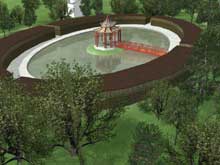|
How Kew Grew
Today, visitors to Kew Gardens enjoy a landscape that is the product of many significant changes. Key features including buildings, treescapes and lawns have played a major part in shaping Kew through time by changing its purpose and its character. Many of these features have been lost forever, while some have changed their appearance through the passage of time.
King's Visualisation Lab (KVL) was commissioned by the Royal Botanic Gardens, Kew, to reconstruct, using computer-based 3D modelling, two important periods in Kew's history focussing upon the years 1763 and 1882. Using an extensive range of archival material including artists' drawings, maps and old photographs, KVL have used 21st century computer technology to transform these traditional 2D resources into evocative 3D representations.
Buildings ranging from grand palaces to small follies were carefully studied from surviving plans and written accounts. This allowed KVL accurately to reconstruct dimensions, colour schemes and architectural details, and long abandoned and forgotten locations were brought back to life. In addition to modelling built structures, the KVL team also created a vast library of accurately represented 'virtual' trees, as well as recreating different lakes, flower beds and paths for both the 1763 and 1882 landscapes.
The project 'How Kew Grew' was an extremely complex undertaking, due both to the vast extent of the Gardens, and to the large amount of structures to be modelled, and would not have been possible without close collaboration between KVL and researchers at Kew. The final animated sequence aims both to entertain and educate visitors to Kew through its exploration of the Garden's changing landscape and architectural history.
| Screen shots taken from 'How Kew Grew' |
|
|

|
|
|
|
|
|
|
|
<<
back to Projects
|
|